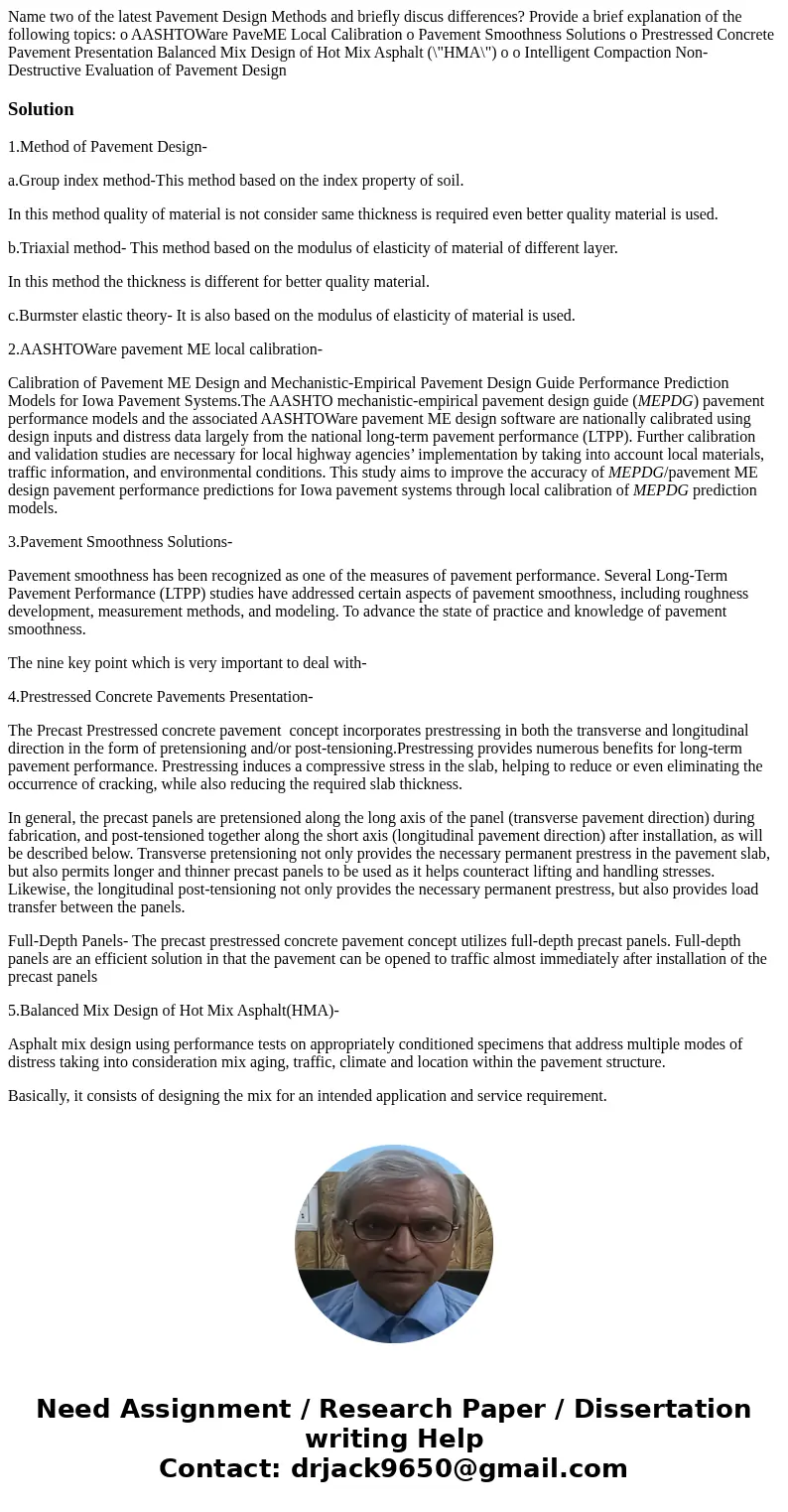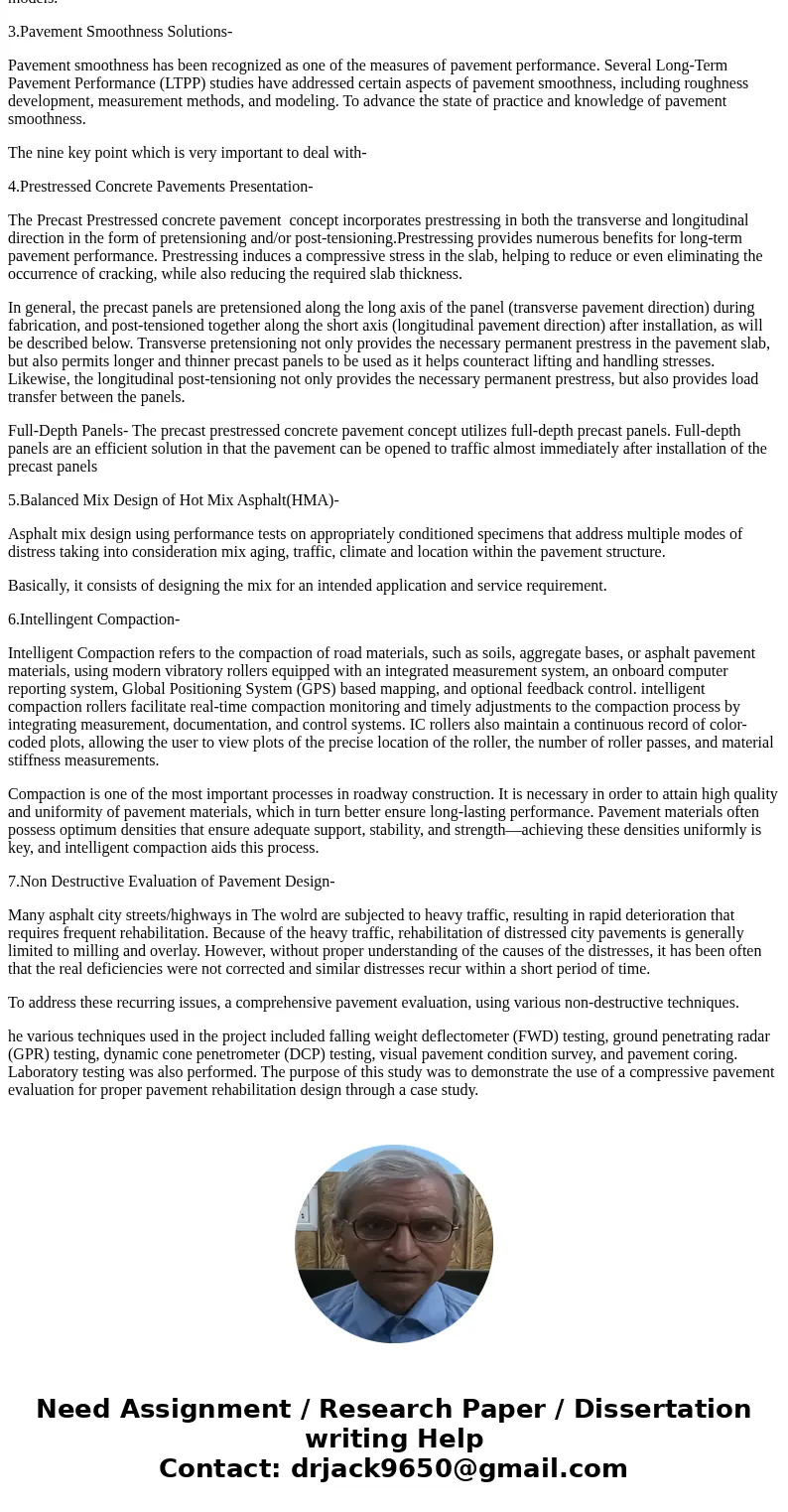Name two of the latest Pavement Design Methods and briefly d
Solution
1.Method of Pavement Design-
a.Group index method-This method based on the index property of soil.
In this method quality of material is not consider same thickness is required even better quality material is used.
b.Triaxial method- This method based on the modulus of elasticity of material of different layer.
In this method the thickness is different for better quality material.
c.Burmster elastic theory- It is also based on the modulus of elasticity of material is used.
2.AASHTOWare pavement ME local calibration-
Calibration of Pavement ME Design and Mechanistic-Empirical Pavement Design Guide Performance Prediction Models for Iowa Pavement Systems.The AASHTO mechanistic-empirical pavement design guide (MEPDG) pavement performance models and the associated AASHTOWare pavement ME design software are nationally calibrated using design inputs and distress data largely from the national long-term pavement performance (LTPP). Further calibration and validation studies are necessary for local highway agencies’ implementation by taking into account local materials, traffic information, and environmental conditions. This study aims to improve the accuracy of MEPDG/pavement ME design pavement performance predictions for Iowa pavement systems through local calibration of MEPDG prediction models.
3.Pavement Smoothness Solutions-
Pavement smoothness has been recognized as one of the measures of pavement performance. Several Long-Term Pavement Performance (LTPP) studies have addressed certain aspects of pavement smoothness, including roughness development, measurement methods, and modeling. To advance the state of practice and knowledge of pavement smoothness.
The nine key point which is very important to deal with-
4.Prestressed Concrete Pavements Presentation-
The Precast Prestressed concrete pavement concept incorporates prestressing in both the transverse and longitudinal direction in the form of pretensioning and/or post-tensioning.Prestressing provides numerous benefits for long-term pavement performance. Prestressing induces a compressive stress in the slab, helping to reduce or even eliminating the occurrence of cracking, while also reducing the required slab thickness.
In general, the precast panels are pretensioned along the long axis of the panel (transverse pavement direction) during fabrication, and post-tensioned together along the short axis (longitudinal pavement direction) after installation, as will be described below. Transverse pretensioning not only provides the necessary permanent prestress in the pavement slab, but also permits longer and thinner precast panels to be used as it helps counteract lifting and handling stresses. Likewise, the longitudinal post-tensioning not only provides the necessary permanent prestress, but also provides load transfer between the panels.
Full-Depth Panels- The precast prestressed concrete pavement concept utilizes full-depth precast panels. Full-depth panels are an efficient solution in that the pavement can be opened to traffic almost immediately after installation of the precast panels
5.Balanced Mix Design of Hot Mix Asphalt(HMA)-
Asphalt mix design using performance tests on appropriately conditioned specimens that address multiple modes of distress taking into consideration mix aging, traffic, climate and location within the pavement structure.
Basically, it consists of designing the mix for an intended application and service requirement.
6.Intellingent Compaction-
Intelligent Compaction refers to the compaction of road materials, such as soils, aggregate bases, or asphalt pavement materials, using modern vibratory rollers equipped with an integrated measurement system, an onboard computer reporting system, Global Positioning System (GPS) based mapping, and optional feedback control. intelligent compaction rollers facilitate real-time compaction monitoring and timely adjustments to the compaction process by integrating measurement, documentation, and control systems. IC rollers also maintain a continuous record of color-coded plots, allowing the user to view plots of the precise location of the roller, the number of roller passes, and material stiffness measurements.
Compaction is one of the most important processes in roadway construction. It is necessary in order to attain high quality and uniformity of pavement materials, which in turn better ensure long-lasting performance. Pavement materials often possess optimum densities that ensure adequate support, stability, and strength—achieving these densities uniformly is key, and intelligent compaction aids this process.
7.Non Destructive Evaluation of Pavement Design-
Many asphalt city streets/highways in The wolrd are subjected to heavy traffic, resulting in rapid deterioration that requires frequent rehabilitation. Because of the heavy traffic, rehabilitation of distressed city pavements is generally limited to milling and overlay. However, without proper understanding of the causes of the distresses, it has been often that the real deficiencies were not corrected and similar distresses recur within a short period of time.
To address these recurring issues, a comprehensive pavement evaluation, using various non-destructive techniques.
he various techniques used in the project included falling weight deflectometer (FWD) testing, ground penetrating radar (GPR) testing, dynamic cone penetrometer (DCP) testing, visual pavement condition survey, and pavement coring. Laboratory testing was also performed. The purpose of this study was to demonstrate the use of a compressive pavement evaluation for proper pavement rehabilitation design through a case study.


 Homework Sourse
Homework Sourse